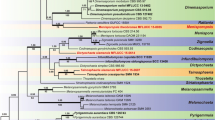Abstract
A new Halosarpheia species, collected from driftwood from Hakkeijima beach, Yokohama, Japan, is described and illustrated and is compared with other species of the genus. The new fungus was growing together with its anamorph on a piece of decaying wood. SSU and LSU rDNA sequences for both morphs were 99% similar. Phylogenetic analyses of SSU and LSU rDNA sequences of the both morphs confirm their anamorph–teleomorph relationship and placed the new fungus in the Halosarpheia sensu stricto clade with high statistical support. Halosarpheia japonica is characterized by its polar appendage that is initially enclosed in a cellular sheath and dissolves in water, the appendage then swells to form a huge tree-like structure. The other three species currently included in Halosarpheia sensu stricto differ from H. japonica by having two polar appendages that uncoil in water to form long filaments.






Similar content being viewed by others
References
Abdel-Wahab MA, Pang KL, El-Sharouney HM, Jones EBG (2001) Halosarpheia unicellularis sp. nov. (Halosphaeriales, Ascomycota) based on morphological and molecular evidence. Mycoscience 42:255–260
Abdel-Wahab MA, Nagahama T, Abdel-Aziz FA (2009) Two new Corollospora species and one new anamorph based on morphological and molecular data. Mycoscience 50:147–155
Abdel-Wahab MA, Pang KL, Nagahama T, Abdel-Aziz FA, Jones EBG (2010) Phylogenetic evaluation of anamorphic species of Cirrenalia and Cumulospora with the description of eight new genera and four new species. Mycol Prog 9:537–558
Anderson JL, Chen W, Shearer CA (2001) Phylogeny of Halosarpheia based on 18S rDNA. Mycologia 93:897–906
Bunyard BA, Nicholson MS, Royse DJ (1994) A systematic assessment of Morchella using RFLP analysis of the 28S rRNA gene. Mycologia 86:762–772
Campbell J, Anderson JL, Shearer CA (2003) Systematics of Halosarpheia based on morphological and molecular data. Mycologia 95:530–552
Felsenstein J (1981) Evolutionary trees from DNA sequences: a maximum likelihood approach. J Mol Evol 17:368–376
Felsenstein J (1985) Confidence limits on phylogenies: an approach using the bootstrap. Evolution 39:783–791
Huelsenbeck JP, Ronquist F (2001) MRBAYES: Bayesian inference of phylogeny. Bioinformatics 17:754–755
Jones EBG, Sakayaroj J, Suetrong S, Somrithipol S, Pang KL (2009) Classification of marine Ascomycota, anamorphic taxa and Basidiomycota. Fungal Diver 35:1–187
Kohlmeyer J, Kohlmeyer E (1977) Bermuda marine fungi. Trans Br Mycol Soc 68:207–219
Kong RYC, Chan JYC, Mitchell JI, Vrijmoed LLP, Jones EBG (2000) Relationships of Halosarpheia, Lignincola and Nais inferred from partial 18S rDNA. Mycol Res 104:35–43
Nylander JAA (2004) MrModeltest v2. Program distributed by the author. Evolutionary Biology Center, Uppsala University, Uppsala
Pang KL, Vrijmoed LLP, Kong RYC, Jones EBG (2003a) Lignincola and Nais, polyphyletic genera of the Halosphaeriales (Ascomycota). Mycol Prog 2:29–36
Pang KL, Vrijmoed LLP, Kong RYC, Jones EBG (2003b) Polyphyly of Halosarpheia (Halosphaeriales, Ascomycota): implications on the use of unfurling ascospore appendages as a systematic character. Nova Hedwigia 77:1–18
Posada D, Crandall KA (1998) MODELTEST: testing the model of DNA substitution. Bioinformatics 14:817–818
Ronquist F, Huelsenbeck JP (2003) MRBAYES 3: Bayesian phylogenetic inference under mixed models. Bioinformatics 19:1572–1574
Swofford DL (2002) PAUP: phylogenetic analysis using parsimony, version 4.0b10. Illinois Natural History Survey, Champion, Ill
Thompson JD, Gibson TJ, Plewniak F, Jeanmougin F, Higgins DG (1997) The ClustalX windows interface: flexible strategies for multiple sequence alignment aided by quality analysis tools. Nucl Acids Res 25:4876–4882
White TJ, Bruns TD, Lee SB, Taylor JW (1990) Analysis of phylogenetic relationships by amplification and direct sequencing of ribosomal DNA genes. In: Innis MA, Gelfand DH, Sninsky JJ, White TJ (eds) PCR protocols: a guide to methods and applications. Academic, San Diego, pp 315–322
Wong MKM, Jones EBG, Abdel-Wahab MA, Au DWT, Vrijmoed LLP (2003) Ultrastructure of conidiogenesis and appendage ontogeny in the coelomycete Bartalinia robillardoides. Can J Bot 81:1083–1090
Acknowledgements
This work was funded by grants from the Japan Society for the Promotion of Science (JSPS) (No. 185701000001 and No. 18-06620). M.A. Abdel-Wahab is grateful to JSPS for an award of a postdoctoral fellowship. We appreciate the comments provided by the two anonymous reviewers and the editor-in-chief, who greatly improved this paper.
Author information
Authors and Affiliations
Corresponding author
Rights and permissions
About this article
Cite this article
Abdel-Wahab, M.A., Nagahama, T. Halosarpheia japonica sp. nov. (Halosphaeriales, Ascomycota) from marine habitats in Japan. Mycol Progress 11, 85–92 (2012). https://doi.org/10.1007/s11557-010-0731-0
Received:
Revised:
Accepted:
Published:
Issue Date:
DOI: https://doi.org/10.1007/s11557-010-0731-0




